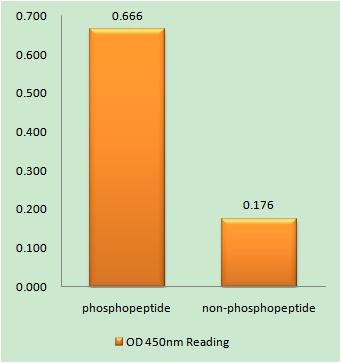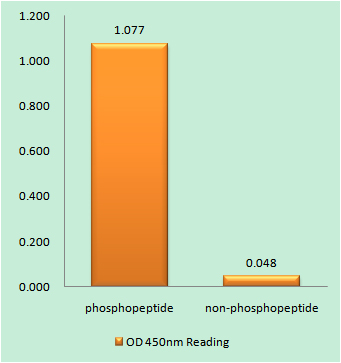
Catalog: YP1194
Size
Price
Status
Qty.
200μL
$600.00
In stock
0
100μL
$340.00
In stock
0
50μL
$190.00
In stock
0
Add to cart


Collected


Collect
Main Information
Target
TERT
Host Species
Rabbit
Reactivity
Human, Rat, Mouse,
Applications
WB, IF, ELISA
MW
127kD (Calculated)
Conjugate/Modification
Phospho
Detailed Information
Recommended Dilution Ratio
IF 1:200-1:1000; WB 1:1000-1:5000; ELISA 1:10000; Not yet tested in other applications;
Formulation
Liquid in PBS containing 50% glycerol, 0.5% BSA and 0.02% sodium azide.
Specificity
Phospho-TERT (S227) Polyclonal Antibody detects endogenous levels of TERT protein only when phosphorylated at S227.The name of modified sites may be influenced by many factors, such as species (the modified site was not originally found in human samples) and the change of protein sequence (the previous protein sequence is incomplete, and the protein sequence may be prolonged with the development of protein sequencing technology). When naming, we will use the "numbers" in historical reference to keep the sites consistent with the reports. The antibody binds to the following modification sequence (lowercase letters are modification sites):GGsAS
Purification
The antibody was affinity-purified from rabbit antiserum by affinity-chromatography using epitope-specific immunogen.
Storage
-15°C to -25°C/1 year(Do not lower than -25°C)
Concentration
1 mg/ml
MW(Calculated)
127kD
Modification
Phospho
Clonality
Polyclonal
Isotype
IgG
Related Products
Antigen&Target Information
Immunogen:
The antiserum was produced against synthesized peptide derived from human Telomerase around the phosphorylation site of Ser227. AA range:196-245
show all
Specificity:
Phospho-TERT (S227) Polyclonal Antibody detects endogenous levels of TERT protein only when phosphorylated at S227.The name of modified sites may be influenced by many factors, such as species (the modified site was not originally found in human samples) and the change of protein sequence (the previous protein sequence is incomplete, and the protein sequence may be prolonged with the development of protein sequencing technology). When naming, we will use the "numbers" in historical reference to keep the sites consistent with the reports. The antibody binds to the following modification sequence (lowercase letters are modification sites):GGsAS
show all
Gene Name:
TERT
show all
Protein Name:
Telomerase reverse transcriptase
show all
Other Name:
TERT ;
EST2 ;
TCS1 ;
TRT ;
Telomerase reverse transcriptase ;
HEST2 ;
Telomerase catalytic subunit ;
Telomerase-associated protein 2 ;
TP2
EST2 ;
TCS1 ;
TRT ;
Telomerase reverse transcriptase ;
HEST2 ;
Telomerase catalytic subunit ;
Telomerase-associated protein 2 ;
TP2
show all
Background:
Telomerase is a ribonucleoprotein polymerase that maintains telomere ends by addition of the telomere repeat TTAGGG. The enzyme consists of a protein component with reverse transcriptase activity, encoded by this gene, and an RNA component which serves as a template for the telomere repeat. Telomerase expression plays a role in cellular senescence, as it is normally repressed in postnatal somatic cells resulting in progressive shortening of telomeres. Deregulation of telomerase expression in somatic cells may be involved in oncogenesis. Studies in mouse suggest that telomerase also participates in chromosomal repair, since de novo synthesis of telomere repeats may occur at double-stranded breaks. Alternatively spliced variants encoding different isoforms of telomerase reverse transcriptase have been identified; the full-length sequence of some variants has not been determined. Alternative sp
show all
Function:
Catalytic activity:Deoxynucleoside triphosphate + DNA(n) = diphosphate + DNA(n+1).,Disease:Activation of telomerase has been implicated in cell immortalization and cancer cell pathogenesis.,Disease:Defects in TERT are a cause of dyskeratosis congenita autosomal dominant (ADDKC) [MIM:127550]; also known as dyskeratosis congenita Scoggins type. ADDKC is a rare, progressive bone marrow failure syndrome characterized by the triad of reticulated skin hyperpigmentation, nail dystrophy, and mucosal leukoplakia. Early mortality is often associated with bone marrow failure, infections, fatal pulmonary complications, or malignancy.,Disease:Defects in TERT are associated with susceptibilty to aplastic anemia (AA) [MIM:609135]. AA is a rare disease in which the reduction of the circulating blood cells results from damage to the stem cell pool in bone marrow. In most patients, the stem cell lesion is caused by an autoimmune attack. T-lymphocytes, activated by an endogenous or exogenous, and most often unknown antigenic stimulus, secrete cytokines, including IFN-gamma, which would in turn be able to suppress hematopoiesis.,Disease:Defects in TERT increases susceptibility to idiopathic pulmonary fibrosis [MIM:178500]. Idiopathic pulmonary fibrosis is an adult-onset, lethal, scarring lung disease of unknown etiology. Its clinical features are shortness of breath, radiographically evident diffuse pulmonary infiltrates, and varying degrees in inflammation, fibrosis, or both on biopsy. It is rapidly progressive and characterized by sequential acute lung injury with subsequent scarring and endstage lung disease.,Disease:Genetic variations in TERT are associated with coronary artery disease (CAD).,Function:Telomerase is a ribonucleoprotein enzyme essential for the replication of chromosome termini in most eukaryotes. It elongates telomeres. It is a reverse transcriptase that adds simple sequence repeats to chromosome ends by copying a template sequence within the RNA component of the enzyme.,similarity:Belongs to the reverse transcriptase family. Telomerase subfamily.,similarity:Contains 1 reverse transcriptase domain.,subunit:Catalytic subunit of the telomerase holoenzyme complex at least composed of TERT, DKC1, WDR79/TCAB1, NOP10, NHP2, GAR1, TEP1, EST1A, POT1 and a telomerase RNA template component (TERC). Interacts with PINX1 and MCRS1.,
show all
Cellular Localization:
Nucleus, nucleolus . Nucleus, nucleoplasm. Nucleus. Chromosome, telomere. Cytoplasm. Nucleus, PML body. Shuttling between nuclear and cytoplasm depends on cell cycle, phosphorylation states, transformation and DNA damage. Diffuse localization in the nucleoplasm. Enriched in nucleoli of certain cell types. Translocated to the cytoplasm via nuclear pores in a CRM1/RAN-dependent manner involving oxidative stress-mediated phosphorylation at Tyr-707. Dephosphorylation at this site by SHP2 retains TERT in the nucleus. Translocated to the nucleus by phosphorylation by AKT.
show all
Tissue Expression:
Expressed at a high level in thymocyte subpopulations, at an intermediate level in tonsil T-lymphocytes, and at a low to undetectable level in peripheral blood T-lymphocytes.
show all
Research Areas:
>>Human papillomavirus infection ;
>>Human T-cell leukemia virus 1 infection ;
>>Pathways in cancer ;
>>Hepatocellular carcinoma ;
>>Gastric cancer
>>Human T-cell leukemia virus 1 infection ;
>>Pathways in cancer ;
>>Hepatocellular carcinoma ;
>>Gastric cancer
show all
Signaling Pathway
Reference Citation({{totalcount}})
Catalog: YP1194
Size
Price
Status
Qty.
200μL
$600.00
In stock
0
100μL
$340.00
In stock
0
50μL
$190.00
In stock
0
Add to cart


Collected


Collect
Recently Viewed Products
Clear allPRODUCTS
CUSTOMIZED
ABOUT US
Toggle night Mode
{{pinfoXq.title || ''}}
Catalog: {{pinfoXq.catalog || ''}}
Filter:
All
{{item.name}}
{{pinfo.title}}
-{{pinfo.catalog}}
Main Information
Target
{{pinfo.target}}
Reactivity
{{pinfo.react}}
Applications
{{pinfo.applicat}}
Conjugate/Modification
{{pinfo.coupling}}/{{pinfo.modific}}
MW (kDa)
{{pinfo.mwcalc}}
Host Species
{{pinfo.hostspec}}
Isotype
{{pinfo.isotype}}
Product {{index}}/{{pcount}}
Prev
Next
{{pvTitle}}
Scroll wheel zooms the picture
{{pvDescr}}

















